WITH an abundance of gothic stone architecture and a large pedestrianised area downtown, Christchurch is more like a quaint old city in Europe than a brash colonial metropolis.
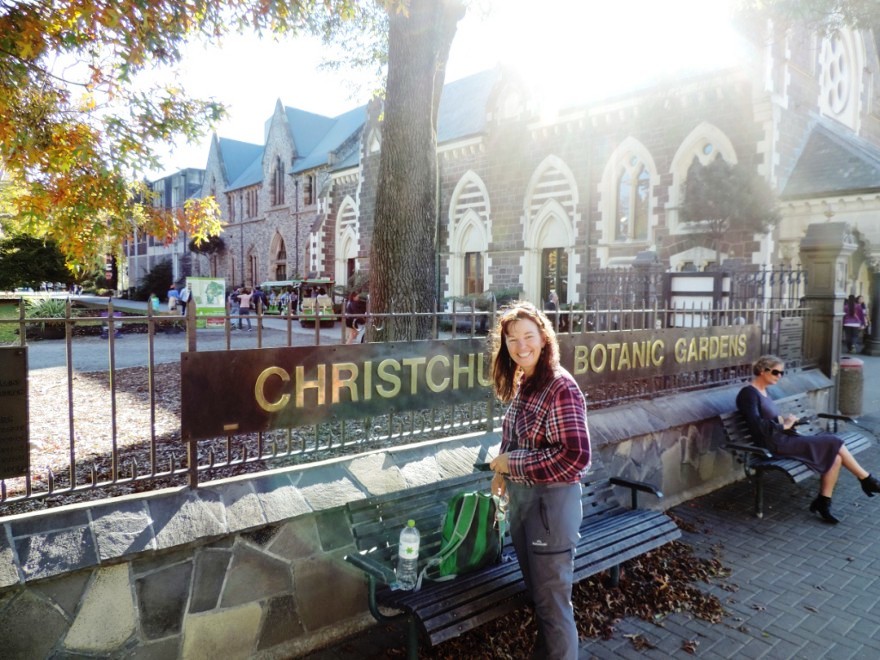
The Christchurch Botanic Gardens, where I’m standing in the photograph above, are next to the Canterbury Museum, founded in 1870, and also on the edge of the vast, downtown, Hagley Park and across the road from the old university buildings, now the Arts Centre.



This older part of Christchurch has long impressed visitors, such as the French intellectual André Siegfried, who wrote after a visit to Christchurch in 1904 that:
The first impression of the new arrival at Christchurch is, "This is England." And in fact the resemblance is striking. The houses are not all built of wood, as in Wellington; most are of brick or grey stone. The streets are straight, long, and almost lively. A pretty river, the Avon, wanders through the town, withi its slow and sinuous course, and is banks are covered with evergreen grass and weeping willows; and here and there are dark stone bridges. It is the green fields of southern England on a smaller scale. At a bend of the small stream there rises a building, slightly gloomy, gothic, crowned with towers, and having a vaguely ecclesiastic appearance; it is the law courts. The English, who know the value of tradition, even in new countries, are extraordinarily skilful in endowing the youngest creations with an ancient air. Many of the churches are of the same style, and give to this town, which has not existed for more than sixty years, the strange, tranquil and respectable appearance of an old European city.
In 1958 the former editor of London's Architectural Review, Nikolaus Pevsner, also marvelled at the qualities of Christchurch's Museum precinct:
The University and the Museum at Christchurch—these were very typical examples of the official architecture of the High Victorian moment. I need not tell you how admirable was the confidence and the ambitiousness to erect such buildings in the sixties and seventies in towns still of a tiny size. They are of course Gothic and they are of the local stones of the South Island. Here again Christchurch and Dunedin read together as against Wellington and Auckland.
He means the sixties and seventies of the 1800s, of course.

In keeping with the ambition of creating a replica of England, nearby Hagley Park contains a sizable oak forest along with many other trees of the northern hemisphere, deciduous sort. Though there are larger forests of oak and other northern hemisphere deciduous trees at Hackfall's Arboretum and at Eastwoodhill, both in northern Hawkes Bay, those are in rural areas and not right in the middle of a city.
It continues to impress the maker of this 2020 video, 'iTraveller':
The Arts Centre and the Museum, renovated some time ago at public expense with just such an eventuality as a big earthquake in mind, came through the Canterbury Earthquakes of 2010 and 2011 quite well.
But there were some sad losses of old heritage in private ownership, some of it pulled down in indecent haste by private owners who didn't want to be lumbered with a site undergoing repair for months or years to come and who did not get not much offer of help from the government of the time; when a few million dollars in relief of the kind paid out in the more recent Covid crisis, ten years after, could have put them at ease.
One of the worst instances of this hasty demolition was Cranmer Courts: a former 1870s official complex comparable to the Museum and the Arts Centre in some ways, but which was later sold off for apartments. Apartments that were quite trendy to live in until the 2011 earthquake put a big (but repairable) crack through the middle of the complex. Down it came!
You might also want to check out the 2011 documentary When a City Falls, with trailer and excerpts here at NZonScreen. Made on the hop in the immediate aftermath of the quakes, the film now has a somewhat more cheerful sequel called When a City Rises:
Christchurch is typical of South Island centres in the sense that the pre-European Māori presence tended to be forgotten about until recently. Siegfried claimed in his book that there was not much of a Māori presence and that the history of Christchurch began with the first European settlers to arrive in the mid-nineteenth century.
But this is not the case. Indeed, Christchurch's river Avon, not named after Shakespeare's Avon but a river of the same name in Scotland, is not known exclusively by that name either. It also bears the Māori name of Ōtākaro, meaning ‘of games’, because children always traditionally played alongside it while adults gathered food such as flounder, eels, ducks, whitebait and freshwater fish from the river, its swampy surroundings and its estuary, which it shares with another small river called the Ōpāwaho, or Heathcote.
Today’s city has the Māori name of Ōtautahi, meaning ‘of Tautahi’, a Rangatira or chief whose pā was on the ground of Banks Peninsula, the rocky quasi-island then known to the Māori as Horomaka or Te Pātaka [storehouse] o Rakaihautū.
Before the days of Tautahi, there was a Waitaha pā on the Ōtākaro called Puari. But in later years it does seem that the site of the future Christchurch was abandoned as a permanent habitation, as opposed to a place where one went to gather food from the marshes.
Whatever way you look at it, the initially rather waterlogged site of the future Christchurch might have been thought an unpromising place on which to found a large city.
And yet there is one now. Indeed, I never get sick of visiting the thriving metropolis of Christchurch, or Ōtautahi, which is in fact now the largest city in the South Island, its current population about 420,000 overall.
Well, first on my list would be the Christchurch Botanic Gardens and Hagley Park, against which I’m photographed at the start. You could spend hours here, even without visiting the adjacent Canterbury Museum, or the Arts Centre across the road.
But there is plenty more to see and do. When I revisited Christchurch just lately, I came across this sign describing fourteen things to do downtown, quite apart from taking in all the parks!

And another sign just below it advertising 4,700 things to do. Both have links on them, to christchurchnz.com/explore and to findchch.com.

I visited the Riverside Market, which was in a new building and about half the size of the vast downtown covered markets in Adelaide, South Australia, which I've blogged about elsewhere, but otherwise quite similar.
%2520cropped.jpeg)
And the new Margaret Mahy Playground, on the banks of the Avon/Ōtākaro, named after a famous author of childrens' books.

It's on the same embankment that you find the Edmonds Telephone Cabinet, gifted to the city in 1929 by Thomas J. Edmonds, the local baking powder magnate. Behind, you can see the Edmonds Clock Tower, also gifted in the same year. Christchurch is full of public-spirited oddities of this sort. Edmonds used to operate a model factory set in beautiful gardens, which graced the cover of their popular cookbooks, sold nationwide. The factory buildings were pulled down in 1991, but you can still visit the gardens.
The earthquake has opened up new views of many heritage buildings, such as the old Government Departmental Buildings at the northern end of Cathedral Square. These are now a hotel and a bar. They remind me of St Petersburg, a bit.

Here's a photo, taken in 1860, which shows the oldest surviving wooden building in downtown Christchurch, erected on land belonging to a farmer named John Shand in Christchurch's downtown Hereford Street, with three other prominent local gents of the time, one of them in an Abraham Lincoln-style top hat, outside the front. The photo is as it appears in a downloadable 1982 Christchurch City Council architectural publication, autocorrected, with a little bit of the white sky cropped off. I don't know whether it's been digitally restored since then.

Anyhow, here's me standing next to it and in front of the Trinity Congregational Church, which opened in 1875 and which lost its tower in the 2011 earthquake. The old wooden building, known in recent times as Shand's Emporium, was relocated to this site in 2015.

Another thing I like seeing in Christchurch right now is all the murals painted on blank walls left exposed by the quakes. There were also some old signs and billboards that suddenly appeared after many years as well. These are documented in the various books of photos that have come out since the quakes.
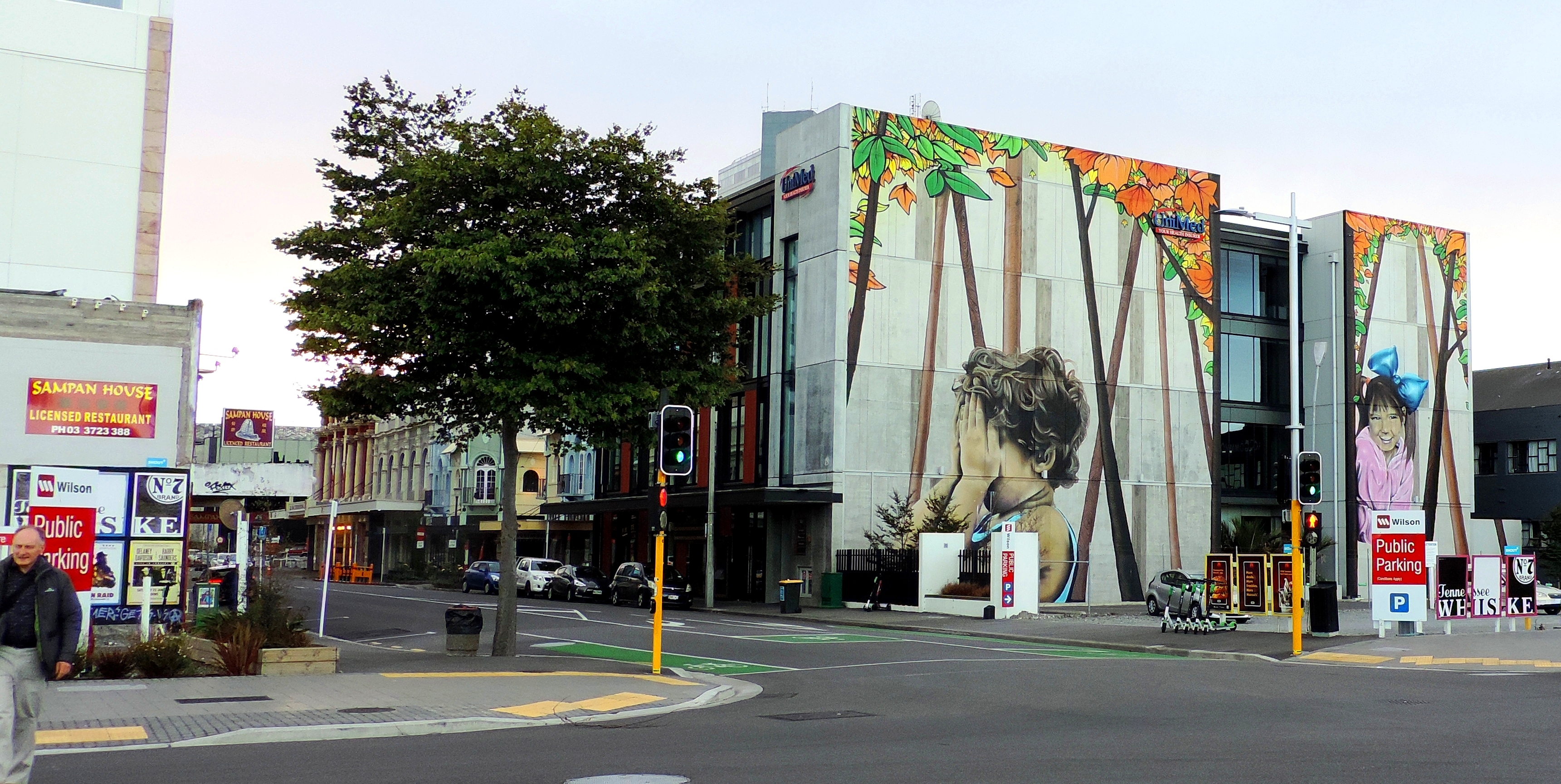
The Spanish-style arcade of New Regent Street, and the nearby Isaac Theatre Royal, are pretty special:

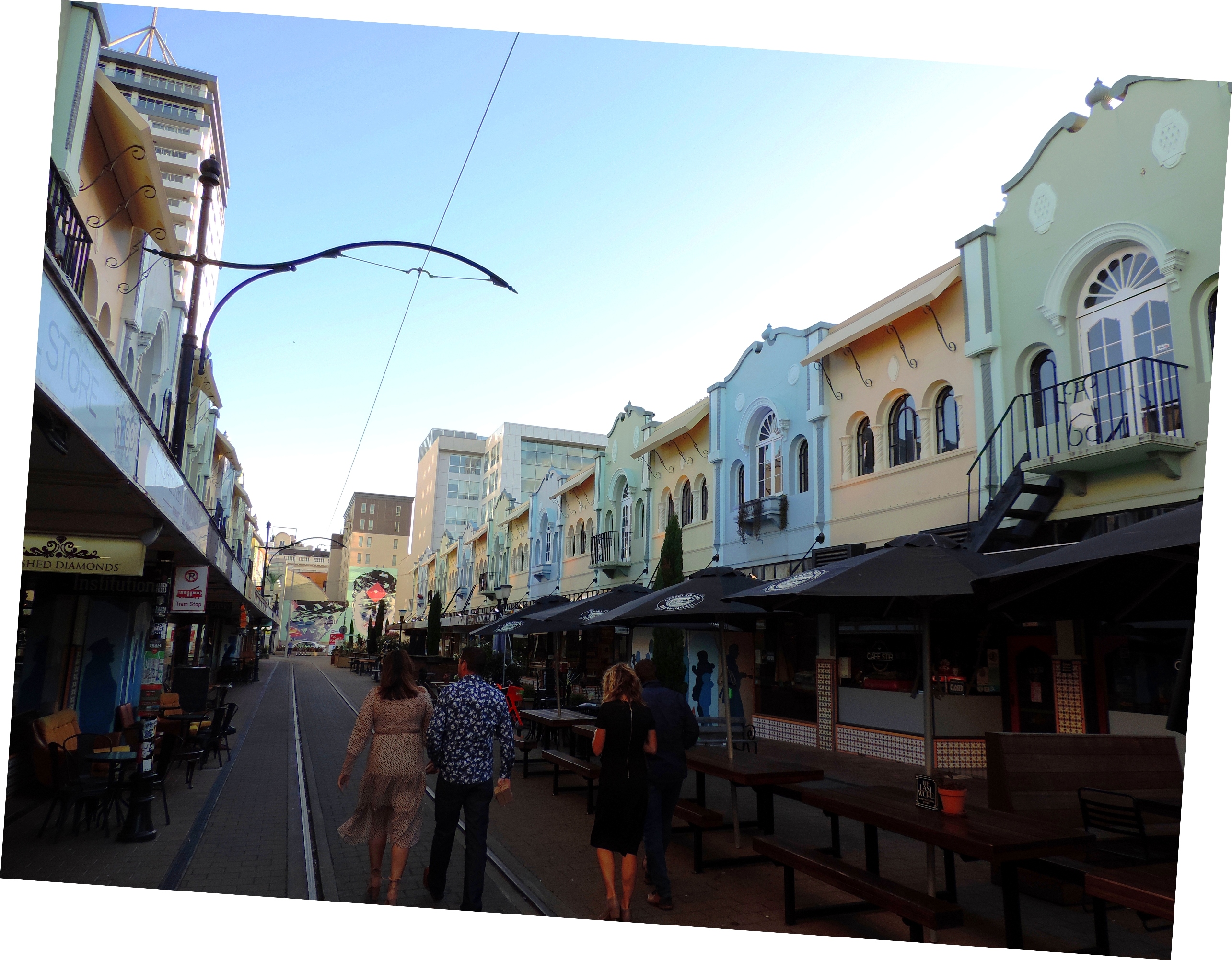
Actually, Christchurch has quite a lot of architectural heritage of the kind that makes it a fun city to walk around in, even if it did lose some in the earthquakes and their aftermath. There's a useful Christchurch City Council brochure that you can download, called City and Architectural Heritage Guide. It sets out more than seventy quirky spots that you can visit downtown, of which I've described just a few.
To continue, Christchurch has strong Antarctic traditions. The New Zealand, American and Italian Antarctic programmes are all based in Christchurch. The unique working museum known as the International Antarctic Centre, beside Christchurch International Airport, is definitely worth a visit.
In town, you can eat lunch below the Robert Falcon Scott Memorial, a statue of the famous Antarctic explorer who began Christchurch’s link with the Antarctic by making the city his base before departing for the pole. Carved by Scott’s widow Kathleen out of white Carrara marble in 1916, the memorial stands on the banks of the Avon/Ōtākaro by Oxford Terrace and is quite impressive.
White marble was chosen because bronze was in short supply due to the First World War. But it was also said to be an appropriate medium because it resembled the ice of the Antarctic.
The statue appears in iTraveller's video above. And there is also an excellent, zoomable image of the Scott Memorial on an old postcard, with detailed notes also, on the website South’s Museum of Postcards.
See, further, the website of the Christchurch Antarctic Office.
The city used to be famous for cycling in the 1950s, till they were driven off the roads by automobile traffic. A documentary made in 1952 claimed that “only Copenhagen is said to boast more bicycles.”
Check it out here! nzonscreen.com/title/christchurch-garden-city-of-new-zealand-1952.
Unfortunately, Christchurch then succumbed to the automobile to a far greater extent than Copenhagen, although the effects were partly remedied by the pedestrianisation of much of downtown Christchurch in the 1970s, including Cathedral Square and Cashel Street. Here's a photo of Cathedral Square in the 1960s, from the Gladys M. Goodall collection at the National Library of New Zealand. In it you can see the Anglican Cathedral, and also the Christchurch War Memorial just to the left of the cathedral, which features an angel breaking a sword. North is toward the left in this photo, taken near sunset.
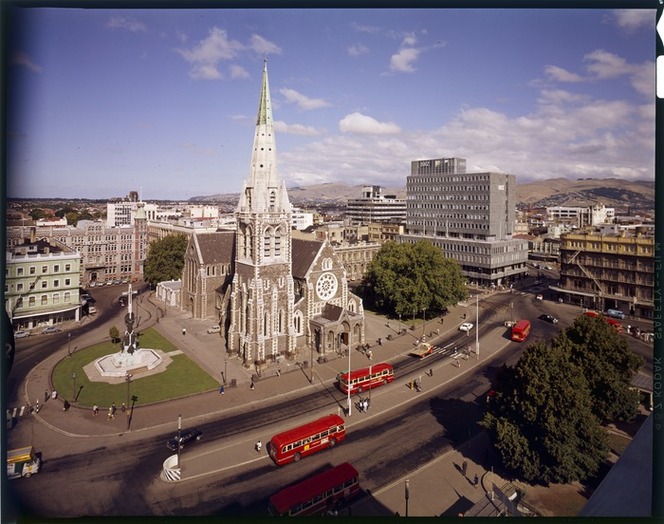
Here’s a picture of me walking through Cathedral Square in autumn, a little west of the the spot where those red buses were, walking toward the right in the photo above, with a statue of an early founder, John Robert Godley, in the background. This statue dates back to 1867 and is the oldest portrait statue in New Zealand by some twenty years.
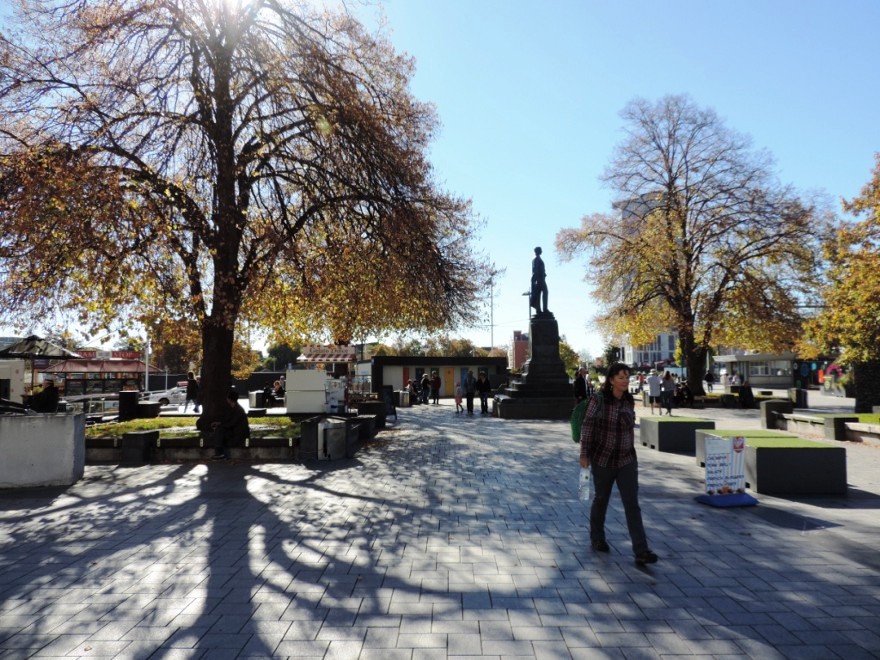
Pedestrianisation was made easier by the development of a system of one-way bypass roads that form a ring around the city centre. As a result, the city centre is fairly quiet. A bit like the eye of a traffic hurricane, perhaps.
After the city centre was pedestrianised, it became a haven for eccentrics, of whom the most famous is the so-called Wizard of Christchurch, Ian Brackenbury Channell, also known as Jack Brackenbury, who erected a stand and started ranting to the public in 1974. The council promptly tried to have him arrested, but after a while they decided that he was a tourist attraction and even paid him a stipend. In 2009, he was awarded the Queen's Service Medal and thus became officially respectable at last: the Wizard, QSM. The Wizard is 88 as of the time of writing so he doesn't get out as much, but still puts in the odd appearance. Here's a recent spot from a British TV programme.
As for the cycling that the city was once so famous for, though it went downhill in the automobile era, there’s now an extensive networkof cycleways in Christchurch, including Te Ara Ōtākaro Avon River Trail.
Since the earthquakes, the city centre has also started to be more or less encompassed, on the non-Hagley Park sides, by a ring of parkland called the Frame, created by leaving a number of demolition sites unbuilt and turning them into parkland instead. This should make the downtown area even more pleasant. The Margaret Mahy Playground is one of the first parts of the Frame to be completed.
It's now relised that some of the land beneath the city wasn't ever fit to be built on at all. This is especially true of the suburban lands beside the Avon/Ōtākaro, which have now been condemned and cleared and are generally known as the Red Zone. This is to be left unbuilt as well, like the Frame, except here it's less of a civic-beautification initiative and more of a necessity.
Although the Avon/Ōtākaro always had an esplanade along its banks from Christchurch's earliest days, there are now competing plans for a massively widened parkland area along its the course of the stream, such as the proposed Avon-Ōtākaro Forest Park. Schemes that also go by the tag of 'greening the red zone'.
For many years, even before the earthquakes, there has also been a tourist tramway, which snakes right through some of the buildings downtown and trundles up and down a number of the downtown’s more quiet streets.

The tramway passes by the Art Deco-style Bridge of Remembrance on Cashel Street
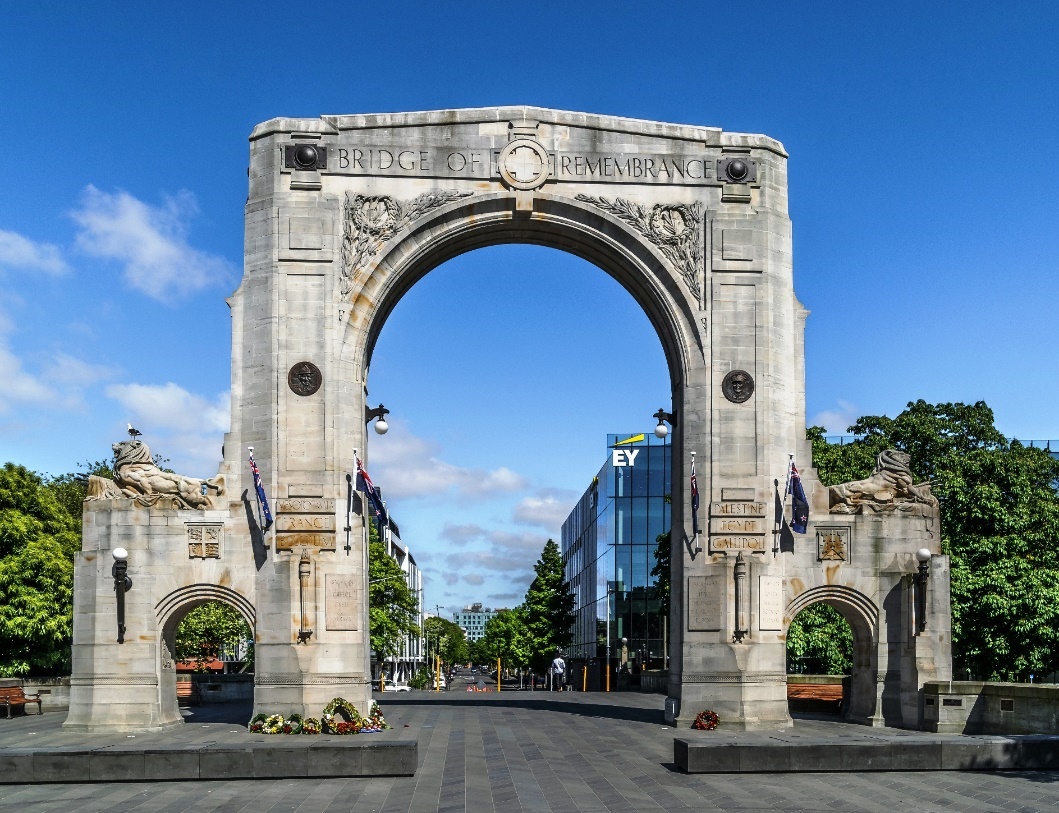
Another Christchurch must-see is the still-damaged Christchurch (Anglican) Cathedral in the middle of Cathedral Square. There also used to be an equally impressive (in fact, arguably more impressive) Catholic basilica a short distance from the Anglican cathedral, but unfortunately its Catholic counterpart could not be saved. Here's a photo of the Anglican Cathedral that my editor took in 2017. It gives a good view of one side of the cathedral and also a closer view of the war memorial. It's hard to reconcile this post-apocalyptic scene with the neatness of Gladys Goodall's 1960s photo. Mind you, I think things have been tidied up a bit since 2017.

There is now also a ‘Cardboard Cathedral’, a temporary but innovative structure designed by the architect Shigeru Ban and made, as the name suggests, of cardboard. Which is apparently quite strong if it’s laminated enough times. Officially called the Transitional Cathedral, this is on the corner of Hereford and Madras Streets.
Meanwhile, restoration of the downtown Anglican cathedral continues slowly.
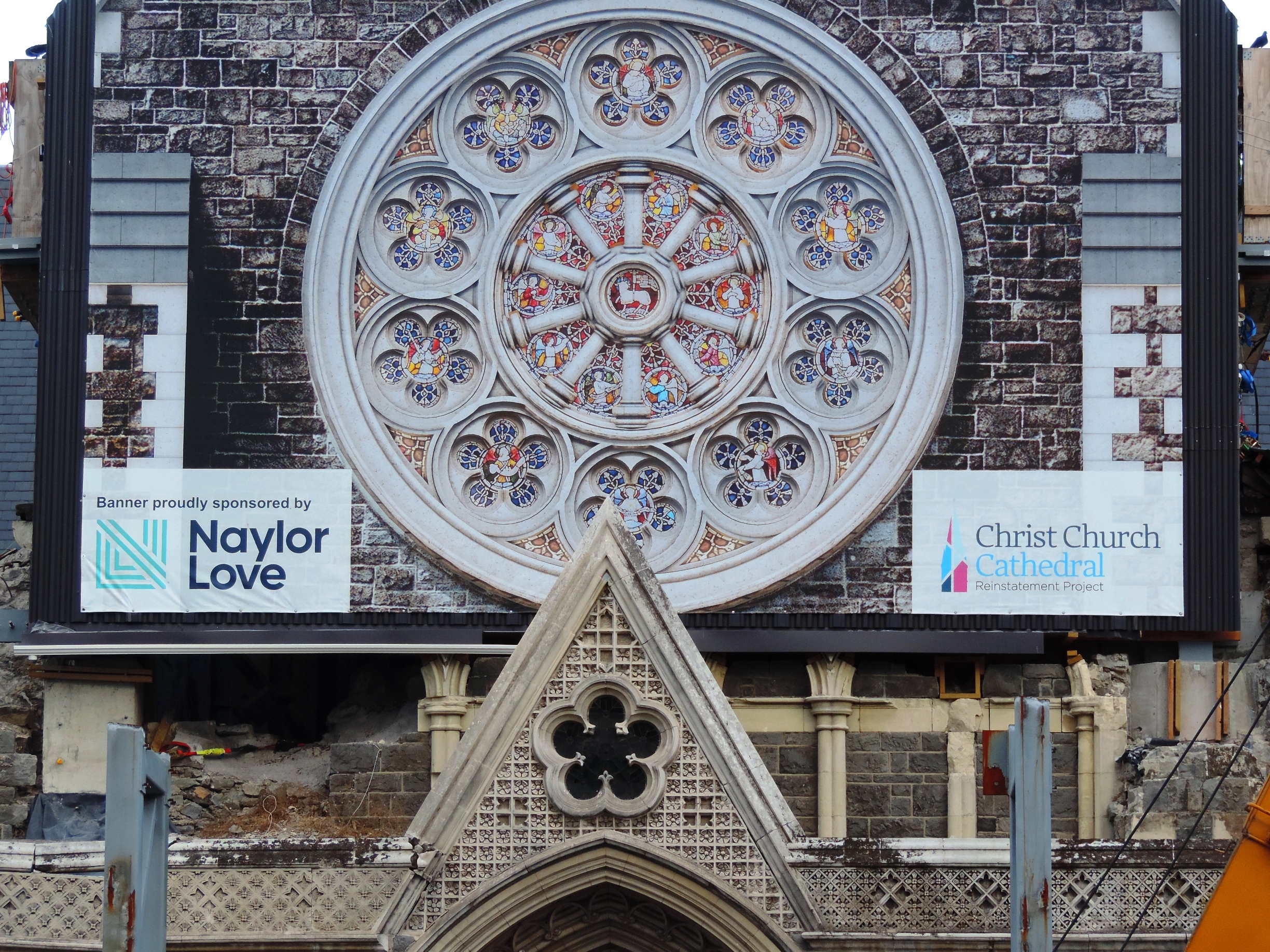
The downtown banks of the Avon/Ōtākaro are especially attractive to wander along as well. These are where you find the Margaret Mahy Playground, the Bridge of Remembrance, other bridges, the Scott Memorial and the Edmonds Clocktower and Telephone Cabinet. You can even go punting! Punts are held in candy-striped wooden buildings that date back to Victorian times, the Antigua Boat Sheds, also known as the Phipps Antigua Boat Sheds, which have been used for their original purpose and in their original form since 1882 (the two-story sheds were built in 1907).

Some of the old wooden buildings and archways in Christchurch are just as interesting as the ones made of stone.
It was near the Avon or Ōtākaro, on the west side of Hagley Park, that the tragic mosque shootings of 2019 took place.
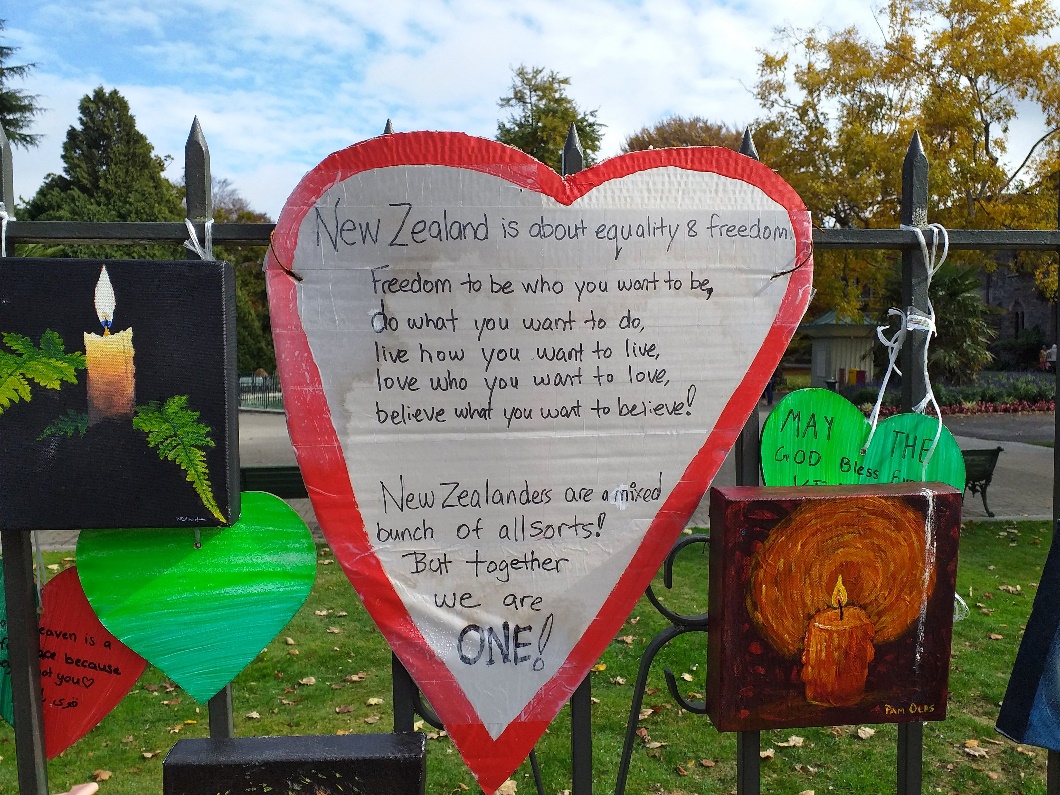
Finally, on a more positive note once more, you can visit the seaside at New Brighton and Sumner Beaches. New Brighton Beach has a pier that sticks out from an 18-km long beach that extends from the Waimakariri River to the tip of Te Karoro Karoro, the Brighton Spit, which guards the estuary of the city's urban rivers.
Whenever I'm in New Brighton I like to visit the bookish café called Switch, in hard-to-find Carnaby Lane. It's darker, and more stuffed with reading matter, than the photos in this story make out, and that's just how I like it.
Sumner Beach has big rocks and is also easier to get to from most parts of town, with a broad promenade and more cafés of the sunlit sort.
The following photograph shows the Brighton Spit just across the estuary from the suburbs of Redcliffs and Moncks Bay. Sumner is just around the headland to the east of Moncks Bay, at the extreme right.
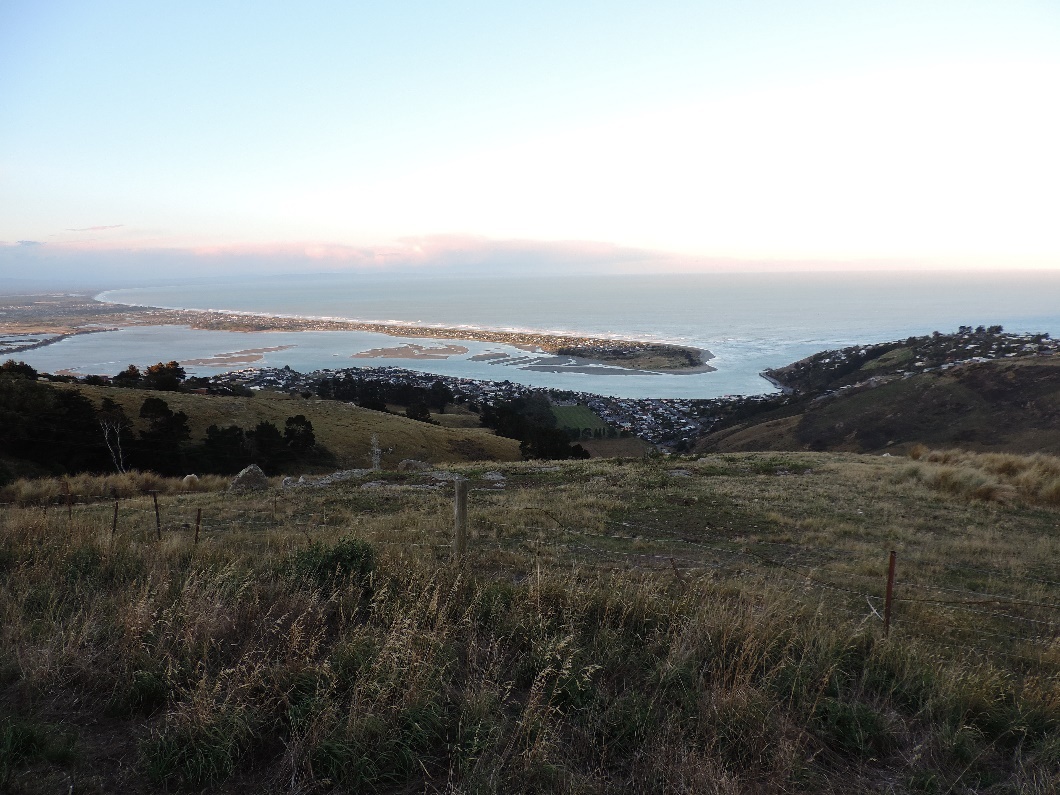
Here's a picture of myself about to ascend the New Brighton Pier, which pokes eastward into the Pacific at the root of the sandspit. You ought to be able to see the pier in the photo above, except I think that in the failing light of evening it has blended into the sea.

See, also, this blog post of mine, which has some more images of Christchurch, including ones that I've reuploaded in this post but also ones I haven't:
a-maverick.com/blog/autumn-impressions-south-island-new-zealand
A guide to New Brighton Beach
A guide to Sumner Promenade
Christchurch Central City Map
And there’s a Christchurch App!

The passage beginning "The first impression of the new arrival at Christchurch . . . " is from André Siegfried, Democracy in New Zealand (E. V. Burns trans.), London, G. Bell & sons Ltd, 1914, p. 253. I am quoting from the online PDF scan at Archive.org. The structure to which Siegfried refers would seem to be the Old Supreme Court Building, which was pulled down in 1980.
The quote from Nikolaus Pevsner comes from his transcribed radio talk 'Towns and Traditions', as published under the major heading 'Architecture in New Zealand', New Zealand Listener, 12 December 1958, page 4.
If you liked the post above, check out my new book about the South Island! It's available for purchase from this website.

Subscribe to our mailing list to receive free giveaways!